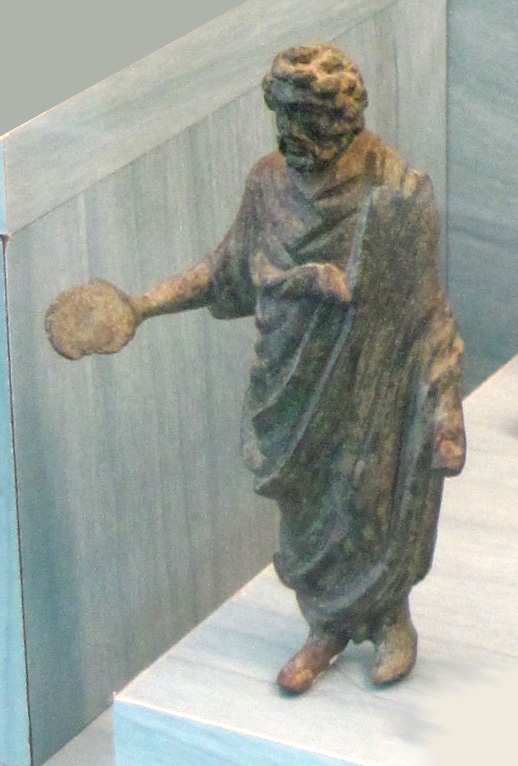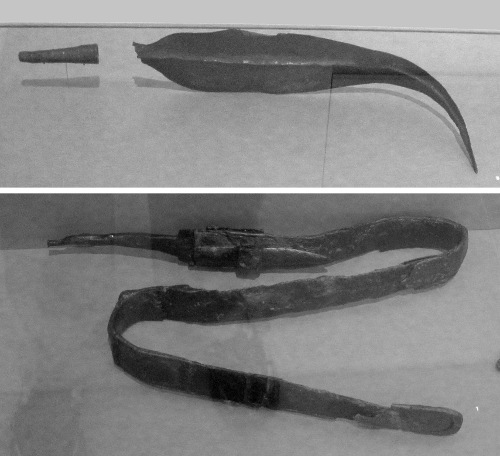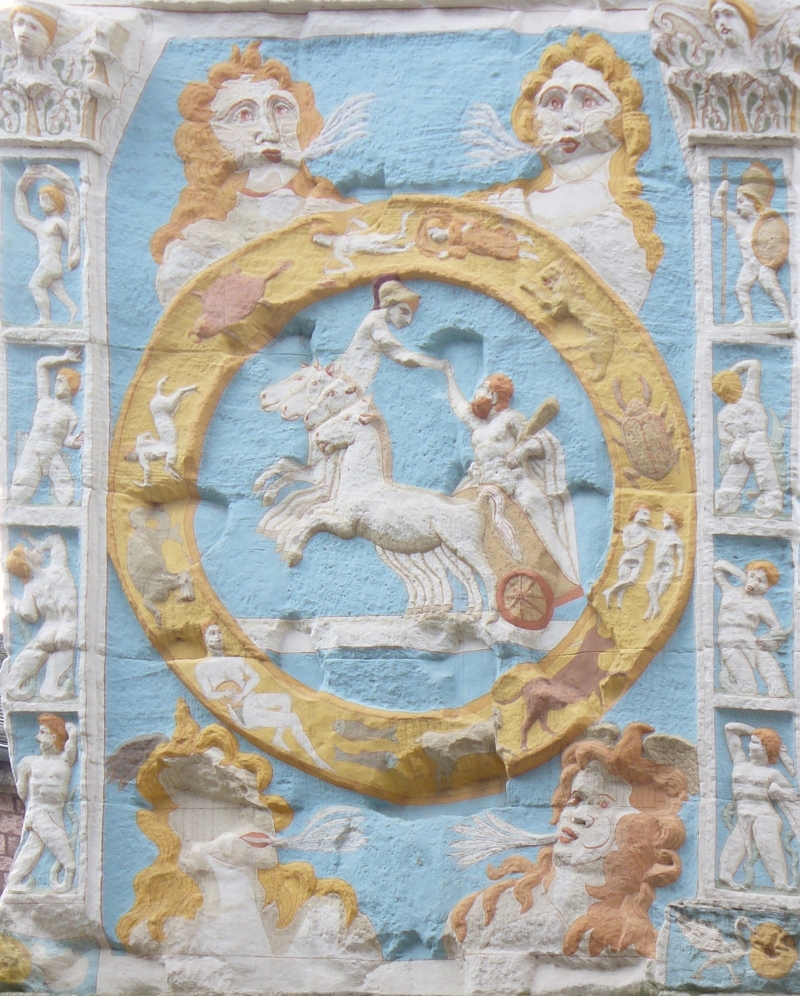
A priest pouring a libation from a patera. (Note that this priest does not cover his head as is usual for sacrifices performed ritu romano, ‘according to the Roman rite’.)
(Musée Rolin, Autun)
Let other religions demand adherence to a creed or a code of beliefs. That is not the pagan way. Our religion is based on deeds, not empty words or the anguished self-indulgence of inner musings. Indeed, it is better not to call our adherents ‘believers’ at all; the ancients used the expression cultórés, ‘worshippers’ or literally ‘cultivators’. Irrelevant to us are the minutiæ of doctrine or the splitting of hairs that distinguish heresy from orthodoxy. The fact of worship is key. Let us but turn our attention to offering due and diligent service to the gods; they will repay us, regardless of whatever theology we may contemplate in our spare time.
In no way does this mean that we have nothing to say on theology or philosophy. On the contrary, pagan ideas on these subjects reached tremendous levels of sophistication, laying the foundation for modern philosophy (and incidentally for modern science as well). What it means is that the act of worship provides a meeting-point for cultórés of various philosophical schools, or none, with the gods. Epicureans and Platonists, Stoics and sceptics, might all offer the same hommage to the immortals, and be benificiaries of the same public sacrifices.

The central act of worship in the greater Roman world is an offering of gifts to the gods. The gods may not need our generosity, being altogether self-sufficient themselves, but the human act of parting with something is an ennobling one which brings us closer to the gods and enables them to partake of their providence.
Gifts can be offered, if only on a modest scale, every single day. Most reconstructionists have a household shrine at which they worship their patron god and/or the lares and genii that protect themselves and their households. Special occasions call for special offerings. If you know other Gaulish reconstructionists in your area, you may choose to meet periodically to celebrate an ancient feast day.
What may a mortal offer to the gods? Historically, the consumption of meat was largely a by-product of animal sacrifice. The sacrifice of animals was as ubiquitous as it was integrated into the economy and lifeways of the ancients. Nowadays, city-dwellers do not slaughter animals on the spot; we buy meat from a supermarket or a butcher’s shop. An offering of meat or offal from either of these sources may be appropriate nowadays. Accompanied by prayers of dedication, the meat can be thrown onto a fire in the open air—a barbecue would be a convenient modern option (at least in good weather). The meat not incinerated (by far the greatest part) can then be desanctified by touching it with the hand and then eaten.
But, despite its iconic quality, animal sacrifice is by no means the only—and probably not the commonest—type of offering attested in our sources. Plant products and foods are extremely widespread gifts. Fruits, grains, mola salsa (a salted flour mixture) and prepared foods can also be thrown onto a fire along the same lines as an offering of offal. Alternatively, they can be presented on an altar, then desanctified and discarded at a later time. Certain leaves and flowers will also be appropriate gifts—or at the very least fine altar decorations!
Libations may be poured out onto the ground or an altar. Alcoholic beverages, especially wine, are the most familiar type of libation; however, water is also sometimes offered, as is olive oil.
It nearly goes without saying that an altar would be incomplete without lighting flames (normally candles, but also bonfires on special occasions) and burning incense.
Besides such immediately perishable materials, a wide variety of items in more durable materials were also offered to the gods. These would not be dedicated on an everyday basis, but in light of special circumstances. This brings us to one of the most fundamental acts of worship in the classical tradition: the making and fulfilment of vows.

Here, a gift is presented neither spontaneously nor as a routine daily offering. A worshipper enters into a solemn contract with one or more divinities, along these lines: ‘If my son comes home safe from the war, I will set up an altar to you on my property.’ ‘If my investment yields such-and-such a dividend, I will donate so-much to such-and-such foundation in your honour.’ ‘If I pass my exam, I will write a hymn to you.’ ‘If such-and-such a person falls in love with me, I will set up a statue of you on my verandah.’
To Christians, the idea of such an exchange—so formal, so legalistic in its terms—may seem crass and supremely un-spiritual. But let us reflect on what it expresses. There is an implicit order in the cosmos in which gods and mortals are partners. There is no necessary rivalry between us; the gods are not monitoring us jealously, keeping an eye out for the slightest fault on our part. Rather, all we need to do is place our trust in their providence and receive whatever goods from them we are fit to take. In recognition of their providential blessing, it is right for us to give them something in exchange. On the other hand, if we do not receive the gifts we had hoped for, evidently there was some reason for it, and we are under no obligation to repay the debt. We need not inveigh against the cruelty of the immortals; there is no crisis of faith. Whatever we would have given up, we now get to keep. (Naturally, this gives us an incentive to set a fair ‘price’ on the gifts we offer to the immortals!) Perhaps some other destiny was in store; perhaps the numen of another god intervened on behalf of another and not ourselves; perhaps the value of the gifts we offered was low relative to our means, thus indicating how little we really wanted what we were asking for, and consequently leaving us the less entitled to the gifts of providence in that regard.
The range of items dedicated ex voto—in fulfillment of a vow—is very wide. They may include:

More in line with Christian preconceptions of what a ‘religious’ experience should be, are the mystery religions. Some of these—such as the Eleusinian or Orphic mysteries, or the cult of the Great Gods at Samothrace—were ancient and well-established in the Græco-Roman world. Others were of more recent introduction and had an ‘exotic’ Oriental image; these include the cult of the Great Mother, of Jupiter Dolichenus, and above all of Mithras.
All of these varied cults had certain traits in common:
In all of these respects we can perceive parallels with Freemasonry today (or, better, in its 18th- and 19th-century heyday). Like Masons, initiates into a mystery cult had no sense that non-initiates were following a ‘false’ religion, even though they themselves might purportedly be in possession of some higher truths. Furthermore, membership in mystery cults was non-exclusive. The emperor Julian was initiated into the Eleusinian mysteries and those of Mithras, and was also a devotee of the Great Mother and of the Unconquered Sun.
What, then, remains for modern reconstructionists who wish to experience the mysteries as our forebears did? Well, unfortunately, nothing direct. We can decorate our houses with the paraphernalia of the ancient mysteries, we can visit the ancient sites of their worship, we can read about the general subject matter and purport of the various cults. But the thing itself is gone. The fellowship and the secrets that it taught have vanished beyond recall.
Besides the Freemasons, another modern analogy—more apt for our present, religious purposes—might be some of the various Druid orders in existence nowadays. Now, some Druid orders are purely Neopagan and even hostile to serious reconstructionism. Others, particularly on the European continent, may be tainted by links to far-right extremism. But there are a few, notably Ár nDraíocht Féin in North America, that embrace actual scholarship and still provide a structured, fraternal approach to their praxis. In France, the Assemblée Druidique du Chêne et du Sanglier does not seem incompatible with reconstructionism. (We must not, of course, confuse such organizations with druids in the historic sense, and in any case their rituals are not to be followed blindly or to the exclusion of others.)
Latin America has a rich tradition of initiatory religions whose main activity is to communicate with spirits (which we would understand as Manes, as genii or as divinities, as the case might be). Such religions—among which I list only Voodoo, Umbanda, Candomblé and Santería—are African (and indeed mainly Yoruba) in tradition, with elements from folk Catholicism and Amerindian religions. I mention them because of the parallels, rather than any direct relationship, that they show for adherents of the religions of Gaul.
A more philosophically-driven praxis would be to follow Plotinus or Iamblichus and seek, through study and contemplation, to achieve a mystical communion with the divine. Iamblichus developed a set of ritual tools and practices to aid this quest which he called theurgy; unfortunately, in his surviving writings he is vague about the details. This, however, is an area where one can learn through experimentation.
Even where my remarks above are too general to warrant specific citation, I would like to credit the following scholars, ancient and modern:

